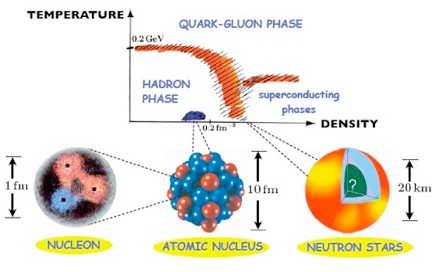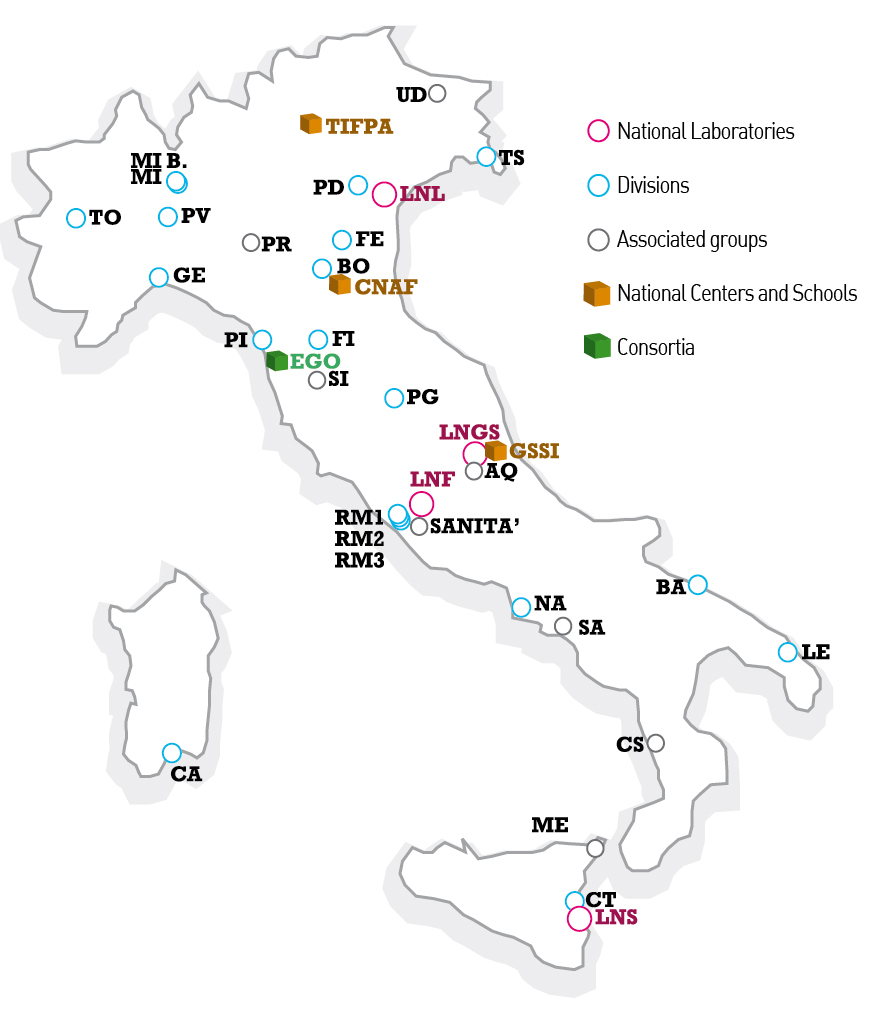NUCSYS
The strongly correlated nuclear system
National Coordinator: Alejandro Kievsky (Pisa)
Staff members:
Giampaolo Co'
Luca Girlanda
Winfried LeidemannGiuseppina Orlandini
Other participants:Ylenia Capitani (Post-doc)
Staff members:
Luciano Canton
Other participants:
Francesca Barbaro (Post-doc)
Yuliia Lashko (Post-doc)
Staff members:
Alejandro Kievsky
Laura Elisa Marcucci
Michele Viviani
Other participants:
Matthias Goebel (Post-doc)
Eleonora Proietti (PhD student)
Staff members:
Nunzio Itaco
Songlin Lyu (Post-doc)
Federico Nola (PhD student)
SELECTED PUBLICATIONS
SIM
Strongly Interacting Matter at high density and temperature
Scientific activities of the various Research Units
The QGP created in the collisions is a highly dynamical system. This makes the extraction of its characteristics and the comparison to the predictions of lattice QCD - obtained at global thermodynamic equilibrium - a challenging task. Many years of theoretical and experimental studies have by now established that the system produced in nuclear collisions is - for a relatively long time - a fluid close to local thermodynamic equilibrium with very low viscosity. This conclusion makes it possible to have meaningful comparisons to the prediction from lattice QCD. However, such a comparison is possible only through the accurate modelling, and corresponding numerical computations, of the dynamical process of a nuclear collision at high energy. One of the main objectives of this network isto develop the theoretical tools to describe the phenomenology of very-high energy nuclear collisions advancing in the quantitative description of the phenomena and predicting new ones. At the same time, we will study QCD in its non-perturbative regime by analytical and numerical methods. This network project gathers Italian researchers working on the physics of Hot QCD matter and the phenomenology of relativistic HIC. Most of the research topics are included in the network activities of STRONG 2020 where some members of this project act also as convener.
1 – IMPACT EARLY STAGE AND NON-EQUILIBRIUM DYNAMICS IN pA-AA
In the recent years, given the success of hydrodynamical approach especially for central AA collisions and the novel findings of collective behavior in pA, it is increasing the interest to study the impact of the very early stage of ultra-relativistic collisions along with the understanding of the dynamics of fast equilibration toward an isotropic and thermalized QGP matter. This study aims also at addressing the question when the hydrodynamic description becomes applicable in AA and pA collisions.This research activity will be possible thanks to the developments in the past years of a transport kinetic theory at fixed shear viscosity over entropy density 𝛈/s (or Knudsen number). A specific objective is to pursue the study of non-equilibrium dynamics by both a full kinetic approach and by a coupling of the last to an initial glasma evolution of the chromomagnetic fields. A specific strength of the project is to quantify the impact on observables thanks to the 3+1D realistic simulations that allows a direct comparison to experimental data. The ultimate ambitious achievement will be to have a novel approach to pA collisions at ultra-relativistic energy above the TeV scale.
2 - QUANTUM EFFECTS IN RELATIVISTIC MATTER AND APPLICATIONS TO HIC
Heavy ion collisions (HIC) stimulated an impressive conceptual leap in the understanding of theoretical foundations of relativistic hydrodynamics. Recently, the discovery of Lambda polarization showed the relevance of quantum physics (the spin) in the relativistic hydrodynamic model of QGP. Therefore, it has become a theoretical major point in this field to understand and establish the quantum statistical foundations of relativistic hydrodynamics in order to have an appropriate framework to study the phenomenology of polarization as well as other long-sought phenomena such as the Chiral Magnetic Effect, which involve quantum field effects. This goal is pursued with different methods and the proposers of this project have developed- in the past years - the formalism of non-equilibrium stationary density operator used to obtain quantum corrections to classical relativistic hydrodynamics expressions. One of the goals of this project is to continue these studies and apply the formalism to the calculations of several relevant quantities such as the dissipative corrections to spin polarization in a relativistic fluid, spin contribution to the entropy current, calculation of spin-spin correlations.
These calculations may be crucial also to account for the yet unsettled discrepancies between data and hydrodynamic model predictions of the azimuthal angle dependence of longitudinal and transverse components of the polarization vector.
3 – MAGNETIC FIELD AND VORTICITY IN RELATIVISTIC HIC
Evidence has been found that the QGP as a fluid develops a large vorticity (𝜔 ≈1021 s-1) and there are indications of a very large initial magnetic field (≈1019 Gauss). These subjects are raising more and more interest in the community and we will continue this study with old and new probes. An accurate map of the relativistic thermal vorticity is essential to study the polarization of the Lambda hyperons (see Item 2) and the magnetic field may play a role in the 𝛬/anti-𝛬 polarization splitting at low energy. Furthermore it has been predicted in the recent past, against naive expectation, that HQ can serve as an excellent probe of both the initial asymmetry in the longitudinal distribution of bulk matter and the strong magnetic field. This is mainly due to the short formation time of charm quarks and their larger thermalization time which has been predicted to enable the generation of a directed flow v1 (a dipole asymmetry in the emission of particles in the transverse plane) more than one order of magnitude w.r.t. light hadrons. We will study this issue both in AA and pA to assess the origin of the v1 of the neutral D0 and anti-D0 . This could also be a probe of deconfinement in the heavy flavor sector and contribute to quantitative predictions for key phenomena like Chiral Magnetic and Vortical Effect, and 𝛬-anti𝛬 polarization.
4 – HEAVY QUARKS DYNAMICS IN HOT QCD MATTER
The theoretical understanding of the strong coupling of Heavy Quark (HQ) to the QGP bulk medium is a main topic that timely meets the main upgrades scheduled by all the experimental collaborations both at LHC and RHIC. LNS and Torino have played a recognized role in a first estimate of the Ds space diffusion coefficient that show agreement with lattice QCD within still large uncertainties. The new stage that is opening will allow to focus the bottom production and access new observables (vn(HQ)-vn (bulk) and angular D-Dbar correlations) pursuing new original aspects of the problem and studying the evolution of the dynamics from pA to AA. A specific strength of the proposed projects is the matching with the developments in item 1 allowing to investigate also the role of the initial glasma dynamics. A further key aspect of HQ physics recently emerged is the large enhancement of 𝛬c production in AA collisions (as predicted by LNS) as well as in pp and pA, making clear that fragmentation function from e+ e - collisions are not appropriate. The objective is to deepen the study of hadronization mechanism by coalescence and/or modified fragmentation function in pp, pA and AA collisions extending the predictions to the bottom sector. The ambitious goal, that may not be reached, would be to achieve a common framework for hadronization in heavy quark sector in nuclear collisions.
5 – NON-PERTURBATIVE APPROACHES TO QCD
The properties of the QGP near the (pseudo) phase transition cannot be studied by means of perturbative expansions because they involve strongly interacting quantum field theory. Several approaches have been devised to obtain information on QCD thermodynamics in this regime and we would like to contribute to the ongoing developments with our expertises. Three methods will be employed: lattice QCD, holographic dualities as well as analytically solvable approach to QCD and effective models. Among the specific objectives of this project, we would like to mention: the topological properties of QCD in the deconfined phase both in lattice QCD and with holographic methods; the estimate of the transport coefficients of heavy quarks in the plasma; the use of Chiral Effective Lagrangians to study the Critical End-Point.
SIM
Strongly Interacting Matter at high density and temperature
Abstract
The aim of the project is to study - theoretically and phenomenologically - the properties of strongly interacting matter at high temperature and density. The theory of strong interactions, Quantum Chromo-Dynamics (QCD) predicts that interacting hadronic matter should undergo a phase transition to a new phase, known as Quark Gluon Plasma (QGP).
 This project has, as experimental counterparts, the experiments on relativistic heavy-ion collisions conducted in various facilities, particularly at the Relativistic Heavy Ion Collider (RHIC) in Brookhaven National Laboratories (USA) and at the Large Hadron Collider (LHC) at CERN, as well as in the upcoming facilities FAIR (GSI, Germany) and NICA (JINR, Dubna).
This project has, as experimental counterparts, the experiments on relativistic heavy-ion collisions conducted in various facilities, particularly at the Relativistic Heavy Ion Collider (RHIC) in Brookhaven National Laboratories (USA) and at the Large Hadron Collider (LHC) at CERN, as well as in the upcoming facilities FAIR (GSI, Germany) and NICA (JINR, Dubna).The thermodynamic and transport properties of strongly interacting matter can be studied theoretically from first principles mostly through numerical computations (lattice QCD). The goal is to connect the properties of the QGP predicted by lattice QCD with the phenomenological description of ultra-relativistic nuclear collisions. For this purpose, it is necessary to use and develop theoretical tools such as relativistic hydrodynamics and relativistic transport theory in extreme conditions, and to perform realistic simulations of nuclear collision dynamics. Another major goal is the development and the use of the insights provided by recent analytical approaches to non perturbative QCD.
The SIM research programme includes several aspects of relativistic heavy-ion collisions that are drawing increasing attention in the community, which are related to the unprecedented conditions of the created matter not just in terms of temperature and density, but also of vorticity (𝜔 ≈1021 s-1 ) and magnetic field (B ≈ 1018 Gauss). These magnitudes were never achieved nor they are achievable otherwise in terrestrial laboratories. This will also match the huge amount of data coming from the RHIC and theHigh Luminosity LHC upgrade. Hence special heed will be devoted to the study of quantum effects in relativistic hydrodynamics such as collective polarization and local parity violation; non-equilibrium dynamics and electromagnetic field in the early stage of the collision, dynamics of heavy quarks and in-medium hadronization. Another major point will be the study of pp and pA collisions that - at very high energy - show striking similarities to nuclei collisions.
SIM
Strongly Interacting Matter at high density and temperature
National Coordinator: Andrea Beraudo (Torino)
● Catania
○ Staff members
- Marco Ruggieri (UniCT, local coordinator)
- Vincenzo Minissale (UniCT)
- Lucia Oliva (UniCT)
- Fabio Siringo (UniCT)
○ Other participants (Post-docs, Ph.D students, retired...)
- Giorgio Comitini (Assegnista UniCT)
- Paolo Castorina (INFN-CT)
● Firenze
○ Staff members
- Francesco Becattini (UniFI, local coordinator)
- Eduardo Grossi (UniFI)
○ Other participants (Post-docs, Ph.D students, retired...)
- Maria Paola Lombardo (INFN-FI)
- Xin-Li Sheng (Post-Doc INFN)
- Daniele Roselli (PhD UniFI)
- Natalia Pinzani Fokeeva
·
● Laboratori Nazionali del Sud
○ Staff members
· Vincenzo Greco -UniCT
· Salvatore Plumari -UniCT
- Coci Gabriele
○ Other participants (Post-docs, Ph.D students,...)
· Asta Angelo (PhD)
· Nugara Vincenzo (PhD)
- Parisi Gabriele (PhD)
· Maria Lucia Sambataro (PhD)
● Torino
○ Staff members
· Marzia Nardi -INFN
· Andrea Beraudo -INFN
· Arturo De Pace -INFN
- Monteno Marco - INFN
- Parotto Paolo - UniTo
○ Other participants (Post-docs, Ph.D students,...)
· Martinez Vera Jorge Manuel (INFN Post Doc)
· Frascà Ferdinando

